refer to exhibit 24-10. the deadweight loss triangle is what area?
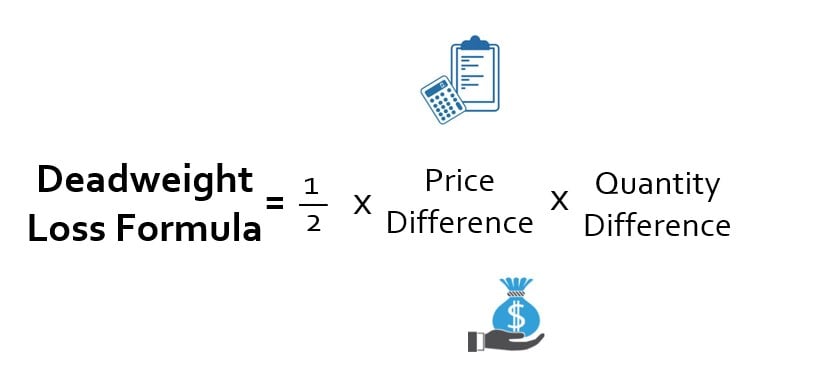
Deadweight Loss Formula (Table of Contents)
- Formula
- Examples
- Calculator
What is the Deadweight Loss Formula?
The term "deadweight loss" refers to the economical loss incurred due to inefficient marketplace condition i.e. demand and supply are out of equilibrium. In other words, deadweight loss indicates that the economic welfare of society is not at its optimum level. Some of the major causes of deadweight losses include rent command (toll ceiling), minimum wage (price floor) and taxation.
The formula for deadweight loss is expressed as the area of the triangle with base equivalent to the difference betwixt prices of the original need curve and new demand bend at the new quantity demanded and peak equivalent to the difference between equilibrium quantities of the original demand curve and new demand curve. Mathematically, it is represented as,
Deadweight Loss = ½ * Price Difference * Quantity Difference
Geometrically, the formula for deadweight loss is expressed as the surface area of ΔIGF as illustrated in the graph shown below, which is divisional past the upward-sloping supply curve, the downward sloping demand curve and the vertical line drawn parallel to ordinate for cost at a new equilibrium point.
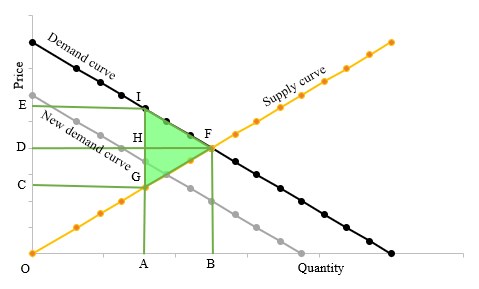
In the in a higher place graph, a point I represents the toll that the consumer was willing to pay initially (original demand bend) and Yard represents the cost that the consumer is currently willing to pay (new demand curve). On the other mitt, points B and A corresponds to the equilibrium quantities of the original and new demand curve respectively. Mathematically, the deadweight loss tin be expressed as,
Deadweight Loss = ½ * IG * HF
(Since AB || HF)
Examples of Deadweight Loss Formula (With Excel Template)
Let's have an example to empathize the calculation of Deadweight Loss in a better manner.
You lot tin download this Deadweight Loss Formula Excel Template here – Deadweight Loss Formula Excel Template
Deadweight Loss Formula – Example #1
Let us accept the instance of demand and price of theatre tickets to illustrate the computation of deadweight loss. In a perfect market scenario, the theatre tickets are priced at $9 with 1,200 attending the movies. Still, the authorities imposed a price floor of $12 due to which the need declined to 800. In the perfect marketplace scenario, 800 people would be attending the movies but of the toll went upto $fifteen. Summate the movie house's deadweight loss in the given scenario.
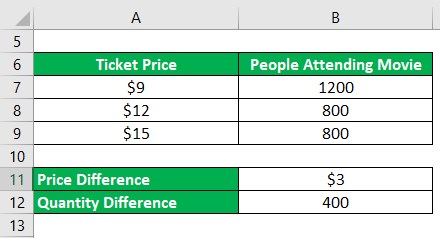
Solution:
Deadweight Loss is calculated using the formula given below
Deadweight Loss = ½ * Price Difference * Quantity Difference
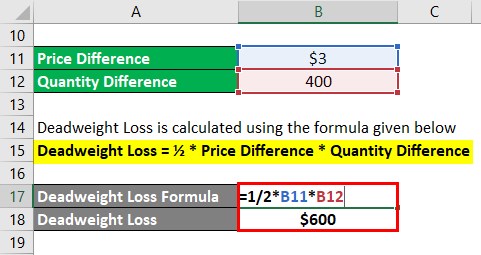
- Deadweight Loss = ½ * $3 * 400
- Deadweight Loss = $600
Therefore, the deadweight loss of the movie theatre, in this case, is equivalent to $600.
Deadweight Loss Formula – Example #2
Let usa take some other example wherein the original demand bend is represented past the equation (-0.08x + 80) and the supply curve past (0.08x), where '10' is the quantity need. Notwithstanding, due to some external factors, the demand curve shifted to (-0.08x + 60). Calculate the deadweight loss based on the given weather condition.
Solution:
Now, permit us build the table for the given original and new demand curves and the supply curve. For a detailed calculation of the same refer to section "Deadweight Loss Formula in Excel".
- At zero need price as per original demand curve = -0.08 * 0 +fourscore = $lxxx
- At goose egg demand cost as per new need curve = -0.08 * 0 +threescore =$60
- At naught need price as per supply curve = 0.08 * 0 = $0
and and so on then along,
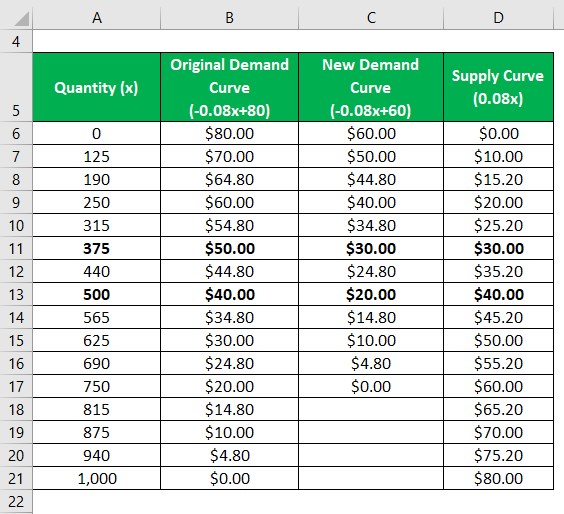
From the in a higher place table, it can be seen that the initial equilibrium quantity is 500 and the new equilibrium quantity is 375. On the other hand, the original price and new toll at the new equilibrium are $50.00 and $xxx.00 respectively.
Therefore,
Price Difference is calculated every bit
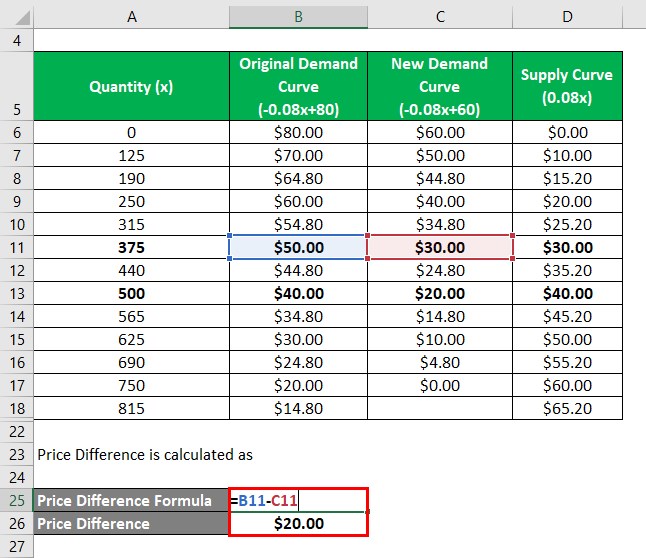
- Cost Deviation = $50.00 – $xxx.00
- Price Difference = $xx.00
Quantity Difference is calculated as
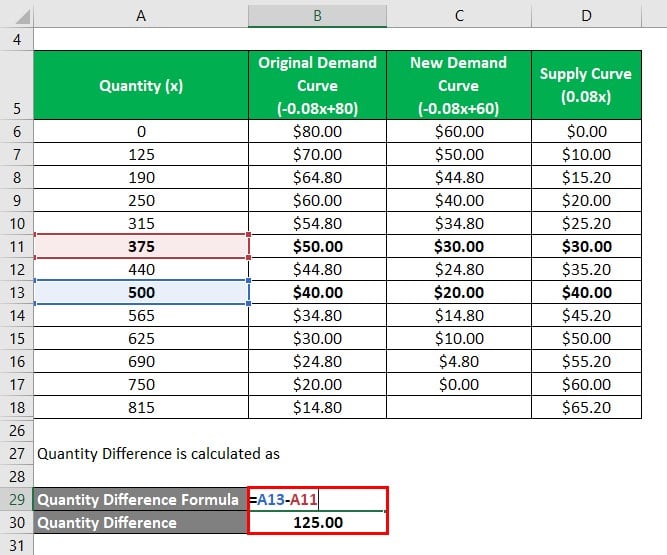
- Quantity Deviation = 500 – 375
- Quantity Departure = 125.00
Deadweight Loss is calculated using the formula given below
Deadweight Loss = ½ * Price Difference * Quantity Difference
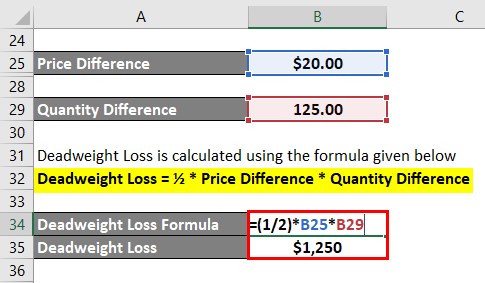
- Deadweight Loss = ½ * $20.00 * 125
- Deadweight Loss = $1,250
Explanation
The formula for deadweight loss can exist derived past using the post-obit steps:
Stride one: Firstly, plot graph for the supply curve and the initial demand curve with a price on the ordinate and quantity on the abscissa. Then, determine the equilibrium quantity, where the demand curve meets the supply curve. In the graph, the equilibrium point is denoted past F and the quantity by OB.
Pace 2: Next, draw the line for the new demand curve which is the actual demand scenario which is out of equilibrium. So, determine the equilibrium quantity at this electric current demand level. In the graph, the indicate is denoted by G and the quantity is denoted by OA.
Stride 3: Next, draw a line parallel to the ordinate and passing through new equilibrium quantity G such that it intersects the original need curve at I. Then, determine the cost that the consumer would accept paid for the original demand level and what information technology volition actually now. The price point on the original demand curve is I and the new demand curve is G, while the prices are OE and OC respectively.
Pace 4: Adjacent, compute the divergence between the original and new equilibrium quantity.
Quantity Deviation = OB – OA = AB
Which is parallel to HF.
Step five: Next, compute the difference between the prices paid for the original and new demand curve at the new equilibrium quantity.
Price Divergence = OE – OC = EC
Which is parallel to IG.
Pace half dozen: Finally, the formula for deadweight loss is expressed as the expanse of the triangle with base equivalent to price deviation (footstep five) and top equivalent to quantity difference (step iv) as shown below.
Deadweight Loss = ½ * Price Difference * Quantity Difference
or
Deadweight Loss = ½ * IG * HF
Relevance and Use of Deadweight Loss Formula
The concept of deadweight loss is important from an economic point of view as it helps is the assessment of the welfare of society. Basically, it is a mensurate of the inefficiency of a market, such that a higher value of deadweight loss indicates a greater degree of inefficiency prevalent in the market. Such losses are witnessed in the market place characterized past oligopoly and monopoly.
Deadweight Loss Formula Calculator
You can employ the following Deadweight Loss Formula Calculator
| Price Difference | |
| Quantity Difference | |
| Deadweight Loss | |
| Deadweight Loss = ½ * | Price Departure * Quantity Departure |
| ½ *0 *0 = 0 |
Source: https://www.educba.com/deadweight-loss-formula/
0 Response to "refer to exhibit 24-10. the deadweight loss triangle is what area?"
Post a Comment